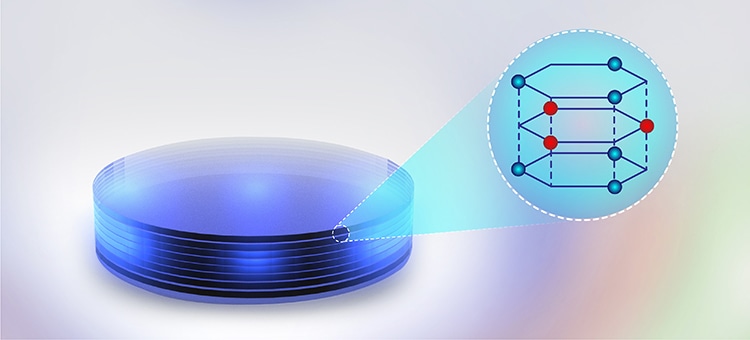Jun 12 2019
Scientists at Chalmers have discovered a totally new method of capturing, amplifying, and linking light to matter at the nanoscale. Using a miniature box, constructed from stacked atomically thin material, they have effectively created a type of feedback loop wherein light and matter combine. The discovery, which was recently reported in Nature Nanotechnology, paves way for new possibilities in the realm of nanophotonics.
 Using a box, built from stacked atomically thin layers of tungsten disulfide material (see the atomic model), Chalmers’ researchers have succeeded in creating a type of feedback loop in which light and matter become one. The box has a diameter of a mere 100 nm (0.00001 cm). (Illustration: Denis Baranov and Yen Strandqvist)
Using a box, built from stacked atomically thin layers of tungsten disulfide material (see the atomic model), Chalmers’ researchers have succeeded in creating a type of feedback loop in which light and matter become one. The box has a diameter of a mere 100 nm (0.00001 cm). (Illustration: Denis Baranov and Yen Strandqvist)
Photonics involves the different means of utilizing light. Fiber-optic communication is an example of photonics, as is the technology underlying solar cells and photodetectors. When the photonic components are so tiny that they are measured in nanometers, this is referred to as nanophotonics. So as to push the limits of what is possible in this miniature format, progress in fundamental research is vital. The state-of-the-art “light box” of the Chalmers scientists makes the changes between light and matter happen so quickly that it is no longer possible to differentiate between the two states. Light and matter unite.
We have created a hybrid consisting of equal parts of light and matter. The concept opens completely new doors in both fundamental research and applied nanophotonics and there is a great deal of scientific interest in this.
Ruggero Verre, Study Co-Author and Researcher, Department of Physics, Chalmers
The discovery happened when Verre and his departmental colleagues Timur Shegai, Denis Baranov, Battulga Munkhbat and Mikael Käll united two diverse concepts in a novel way. Mikael Käll’s research team is working on what is termed as nanoantenna, which can trap and amplify light in the most efficient way. Timur Shegai’s team is carrying out research into a specific type of atomically thin 2D material known as TMDC material, which looks like graphene. It was by merging the antenna concept with stacked 2D material that the new possibilities were developed.
The scientists used a familiar TMDC material – tungsten disulfide – but in a different way. By building a miniature resonance box – quite like the sound box on a guitar – they managed to make the light and matter act together inside it. The resonance box guarantees that the light is captured and bounces round in a definite “tone” within the material, thus guaranteeing that the light energy can be successfully conveyed to the electrons of the TMDC material and back again. Light energy tends to vacillate between the two states – light waves and matter – while it is captured and amplified inside the box. The scientists have been successful in unifying light and matter very efficiently in a single particle having a diameter of just 100 nm, or 0.00001 cm.
This all-in-one solution is an unanticipated advance in fundamental research, but can probably also add to more compact and economical solutions in applied photonics.
We have succeeded in demonstrating that stacked atomically thin materials can be nanostructured into tiny optical resonators, which is of great interest for photonics applications. Since this is a new way of using the material, we are calling this ‘TMDC nanophotonics’. I am certain that this research field has a bright future.
Timur Shegai, Study Co-Author and Associate Professor, Department of Physics, Chalmers